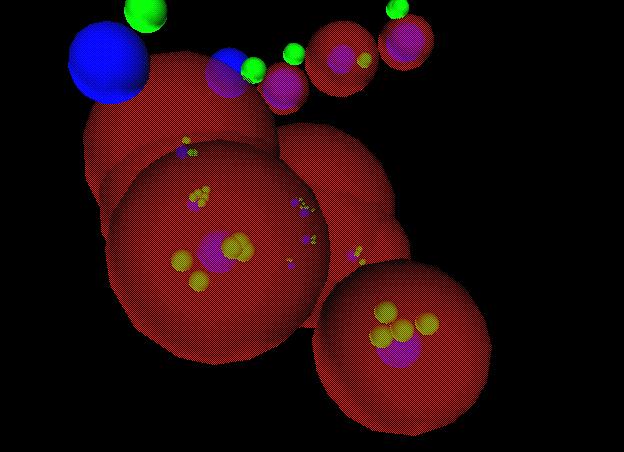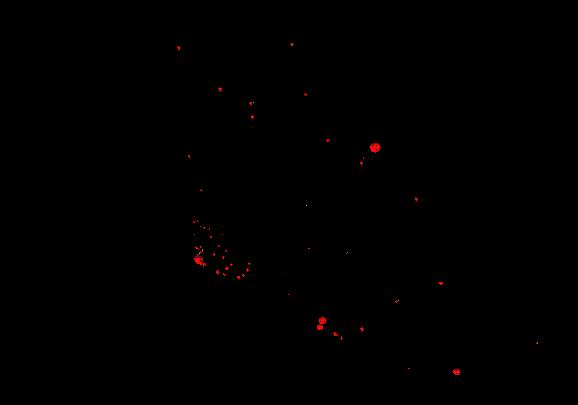


Next: Auto-catalytic evolution
Up: Provoking a Spontaneous
Previous: Provoking a Spontaneous
This configuration offers two advantages over the original single-computer
version of Tierra: greater size, and greater complexity of temporal and
spatial patterns of resources.
There will be a dramatic increase in the size of the space, and the amount
of CPU cycles available to the digital organisms. The single-machine version
is generally run with a memory space of one or two hundred thousand bytes.
However, a single complex digital organism could exceed that size.
It is believed that evolution can only generate great complexity in the
context of an evolving ecological community, as biotic evolutionary
interactions are an important driving force in evolution. Thus we need
a space that can hold entire populations of many species of large organisms.
Suppose that we want to support, minimally, a hundred species, each
with populations of five hundred individuals, with individuals of
ten thousand bytes in size. This would require a space of about five
hundred megabytes. While this space could be achieved on a single computer,
there would be a very bad ratio of memory to CPU power. Distributing
the memory over many computers provides a better memory/CPU ratio.
While greater size is an absolute requirement, large size alone
would probably not provoke evolution towards greater complexity.
However, the distributed model provides a great complexity of temporal
and spatial patterns of resources. It is felt that this complexity could
provide selective pressures for evolution to create complex adaptations
to those patterns.
The network Tierra software will be run as a low-priority background
process, like a screen saver. This means that when the user is actively
using the computer, the Tierra software will sleep, receiving no CPU
cycles, the energy source for the digital organisms. Any digital
organisms who are present on the machine at that time will be frozen,
unable to metabolize or reproduce.
This should create a strong selective pressure for individuals to
move about the net, avoiding sleeping Tierra programs, and seeking those
with a rich supply of CPU cycles. Evolution may generate behaviors that
respond to temporal patterns in the availability of CPU cycles. For
example, there is likely to be a daily cycle, with generally more free
cycles at night when people are sleeping. So some digital organisms might
evolve the behavior of migrating around the planet on a daily basis
staying on the dark side of the planet.
Figure 12: Two images from the
VRML Visualization of Network Tierra
(http://vrml.arc.org/tierra).
This visualization represents the Tierra network environment
though the ``eyes'' of the digital organisms themselves.
Digital organisms are able to perceive conditions on the
net by using the TPing sensory mechanism (sort of like echo
location in bats). These images visualize the data provided
by TPing.
 Close up view of Network Tierra visualization. The diameter of the
orange sphere is proportional to the amount of memory available to
the digital organisms on a node (the soup size); the diameter of
the blue sphere (usually) within the orange sphere represents the
speed of the processor, measured as virtual machine instructions
executed per second; around each blue sphere is a cluster of
yellow-green spheres, each of these represents the presence of
one hundred digital organisms in that soup. Not that the node
represented by the spheres on the lower right of the image has
four yellow-green spheres, indicating the presence of four hundred
digital organisms on that machine. In the upper left is a machine
with a small soup and a fast processor, so the small orange sphere is
hidden inside the large blue sphere, and being a small soup, there
are only one hundred digital organisms on that machine (note one
yellow-green sphere).
Close up view of Network Tierra visualization. The diameter of the
orange sphere is proportional to the amount of memory available to
the digital organisms on a node (the soup size); the diameter of
the blue sphere (usually) within the orange sphere represents the
speed of the processor, measured as virtual machine instructions
executed per second; around each blue sphere is a cluster of
yellow-green spheres, each of these represents the presence of
one hundred digital organisms in that soup. Not that the node
represented by the spheres on the lower right of the image has
four yellow-green spheres, indicating the presence of four hundred
digital organisms on that machine. In the upper left is a machine
with a small soup and a fast processor, so the small orange sphere is
hidden inside the large blue sphere, and being a small soup, there
are only one hundred digital organisms on that machine (note one
yellow-green sphere).
 Wide view of Network Tierra visualization. This is a view of
a medium sized Tierra network, with about one hundred participating
machines. The machines are located at ATR in Japan,
The University of Delaware, The Santa Fe Institute,
The Free University of Brusells,
and the Swiss Federal Institute in Lausanne.
Each machine is visualized as a set of spheres (one
orange, one blue, and a few yellow-green), as described above.
The network is represented from the perspective of one digital
organism, located on a specific machine (in Santa Fe).
The spheres representing the hundred machines are arranged onto
the surface of a cone, with the point-of-view machine at the
tip of the cone (a little below and left of center). The remaining
machines are arranged in spirals on the surface of the cone,
but with their distance from the tip proportional to the time
that it takes the TPing message to cross the net and return.
This network transit time is the most meaningful measure of
distance on the network, and it is provided with the TPing data.
Wide view of Network Tierra visualization. This is a view of
a medium sized Tierra network, with about one hundred participating
machines. The machines are located at ATR in Japan,
The University of Delaware, The Santa Fe Institute,
The Free University of Brusells,
and the Swiss Federal Institute in Lausanne.
Each machine is visualized as a set of spheres (one
orange, one blue, and a few yellow-green), as described above.
The network is represented from the perspective of one digital
organism, located on a specific machine (in Santa Fe).
The spheres representing the hundred machines are arranged onto
the surface of a cone, with the point-of-view machine at the
tip of the cone (a little below and left of center). The remaining
machines are arranged in spirals on the surface of the cone,
but with their distance from the tip proportional to the time
that it takes the TPing message to cross the net and return.
This network transit time is the most meaningful measure of
distance on the network, and it is provided with the TPing data.
However, there will be many deviations from such patterns (as hackers
work late, or people run simulations or number crunchers over-night).
Therefore selection would also favor the ability to sense moment-to-moment
conditions on the net, and move accordingly. In general, selection would
favor the ability to ``intelligently'' navigate the net, foraging for
CPU and memory resources. Thus network digital organisms should become
agile autonomous network agents.



Next: Auto-catalytic evolution
Up: Provoking a Spontaneous
Previous: Provoking a Spontaneous
Thomas S.Ray
Mon Jul 15 15:51:28 JST 1996
 Close up view of Network Tierra visualization. The diameter of the
orange sphere is proportional to the amount of memory available to
the digital organisms on a node (the soup size); the diameter of
the blue sphere (usually) within the orange sphere represents the
speed of the processor, measured as virtual machine instructions
executed per second; around each blue sphere is a cluster of
yellow-green spheres, each of these represents the presence of
one hundred digital organisms in that soup. Not that the node
represented by the spheres on the lower right of the image has
four yellow-green spheres, indicating the presence of four hundred
digital organisms on that machine. In the upper left is a machine
with a small soup and a fast processor, so the small orange sphere is
hidden inside the large blue sphere, and being a small soup, there
are only one hundred digital organisms on that machine (note one
yellow-green sphere).
Close up view of Network Tierra visualization. The diameter of the
orange sphere is proportional to the amount of memory available to
the digital organisms on a node (the soup size); the diameter of
the blue sphere (usually) within the orange sphere represents the
speed of the processor, measured as virtual machine instructions
executed per second; around each blue sphere is a cluster of
yellow-green spheres, each of these represents the presence of
one hundred digital organisms in that soup. Not that the node
represented by the spheres on the lower right of the image has
four yellow-green spheres, indicating the presence of four hundred
digital organisms on that machine. In the upper left is a machine
with a small soup and a fast processor, so the small orange sphere is
hidden inside the large blue sphere, and being a small soup, there
are only one hundred digital organisms on that machine (note one
yellow-green sphere).
 Wide view of Network Tierra visualization. This is a view of
a medium sized Tierra network, with about one hundred participating
machines. The machines are located at ATR in Japan,
The University of Delaware, The Santa Fe Institute,
The Free University of Brusells,
and the Swiss Federal Institute in Lausanne.
Each machine is visualized as a set of spheres (one
orange, one blue, and a few yellow-green), as described above.
The network is represented from the perspective of one digital
organism, located on a specific machine (in Santa Fe).
The spheres representing the hundred machines are arranged onto
the surface of a cone, with the point-of-view machine at the
tip of the cone (a little below and left of center). The remaining
machines are arranged in spirals on the surface of the cone,
but with their distance from the tip proportional to the time
that it takes the TPing message to cross the net and return.
This network transit time is the most meaningful measure of
distance on the network, and it is provided with the TPing data.
Wide view of Network Tierra visualization. This is a view of
a medium sized Tierra network, with about one hundred participating
machines. The machines are located at ATR in Japan,
The University of Delaware, The Santa Fe Institute,
The Free University of Brusells,
and the Swiss Federal Institute in Lausanne.
Each machine is visualized as a set of spheres (one
orange, one blue, and a few yellow-green), as described above.
The network is represented from the perspective of one digital
organism, located on a specific machine (in Santa Fe).
The spheres representing the hundred machines are arranged onto
the surface of a cone, with the point-of-view machine at the
tip of the cone (a little below and left of center). The remaining
machines are arranged in spirals on the surface of the cone,
but with their distance from the tip proportional to the time
that it takes the TPing message to cross the net and return.
This network transit time is the most meaningful measure of
distance on the network, and it is provided with the TPing data.